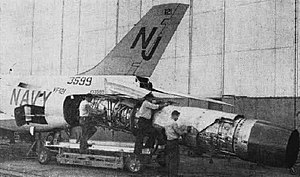Allison J71
Appearance
| J71 | |
|---|---|

| |
| J71 engine change in progress on a F3H-2 Demon, 1963. | |
| Type | Turbojet |
| Manufacturer | Allison Engine Company |
| First run | 1950 |
| Major applications | B-66 Destroyer F3H Demon |
| Developed from | Allison J35 |
The Allison J71 was a single spool turbojet engine, designed and built in the United States. It began development in 1948 as a much modified J35, originally designated J35-A-23.[1]
Operational history
[edit]The Allison J71 turbojet powered the Douglas B-66 Destroyer and the McDonnell F3H-2 Demon after the failed Westinghouse J40 proved unworkable. The prototype P6M-1 SeaMasters were also fitted with the engine.
Variants
[edit]Data from: Aircraft engines of the World 1953[2]
- J71-A-1
- J71-A-2
- Powered the McDonnell F3H Demon
- J71-A-2B
- J71-A-2E
- 9,700 lbf (43.15 kN) thrust (14,000 lbf (62.28 kN) thrust with afterburner), for the McDonnell F3H-2 Demon.
- YJ71-A-3
- 7,000 lbf (31.14 kN) thrust (9,500 lbf (42.26 kN) thrust with afterburner)
- J71-A-4
- Afterburning turbojet engines for the Martin XP6M-1 Seamaster flying boat prototypes.
- J71-A-6
- Afterburning turbojet engines for the Martin YP6M-1 Seamaster pre-production flying boats.
- J71-A-7
- 14,000 lbf (62.28 kN) thrust with afterburner
- J71-A-9
- Powered the Douglas RB-66 Destroyer
- J71-A-11
- 10,200 lbf (45.37 kN) thrust
- J71-A-13
Specifications (Allison J71-A-2)
[edit]Data from Aircraft engines of the World 1957[3]
General characteristics
- Type: afterburning turbojet
- Length: 284.5 in (7,230 mm)
- Diameter: 39.5 in (1,000 mm)
- Frontal area: 8.5 sq ft (0.79 m2)
- Dry weight: 4,890 lb (2,220 kg)
Components
- Compressor: 16-stage axial compressor
- Combustors: cannular with 10 flame tubes
- Turbine: 3-stage axial
- Fuel type: JP-4 / aviation kerosene
- Oil system: pressure spray with scavenge at 10–60 psi (69–414 kPa)
Performance
- Maximum thrust: take-off, dry 10,000 lbf (44,000 N); take-off, wet 14,000 lbf (62.28 kN)
- Overall pressure ratio: 8.0:1
- Air mass flow: 160 lb/s (73 kg/s) at 6,100 rpm (static)
- Specific fuel consumption: 1.8 lb/(lbf⋅h) (51 g/(kN⋅s)) with afterburner (wet)
- Thrust-to-weight ratio: 2.857
See also
[edit]Related development
Related lists
References
[edit]Wikimedia Commons has media related to Allison J71.
- ^ Gunston, Bill (1989). World Encyclopaedia of Aero Engines (2nd ed.). Cambridge, England: Patrick Stephens Limited. p. 11. ISBN 978-1-85260-163-8.
- ^ Wilkinson, Paul H. (1953). Aircraft engines of the World 1953 (11th ed.). London: Sir Isaac Pitman & Sons Ltd. pp. 64–65.
- ^ Wilkinson, Paul H. (1957). Aircraft engines of the World 1957 (15th ed.). London: Sir Isaac Pitman & Sons Ltd. pp. 74–75.
Further reading
[edit]- Kay, Anthony L. (2007). Turbojet History and Development 1930-1960 Volume 2:USSR, USA, Japan, France, Canada, Sweden, Switzerland, Italy and Hungary (1st ed.). Ramsbury: The Crowood Press. ISBN 978-1861269393.
- "Aero Engines 1957". Flight and Aircraft Engineer. 72 (2531): 111–143. 26 July 1957. Retrieved 16 March 2019.
- "J71 Allison's Big Axial Turbojet". Flight and Aircraft Engineer. 67 (2418): 733. 27 May 1955. Retrieved 16 March 2019.
External links
[edit]- "Allison J71 Turbojet". shanaberger.com. Archived from the original on 19 October 2006. Retrieved 16 March 2019.
- "J71 Allison, USA". www.leteckemotory.cz (in Czech). Prague. Retrieved 16 March 2019.
